Adolphe Joseph Thomas Monticelli stands as a unique and somewhat enigmatic figure in the landscape of 19th-century French art. Born into an era of artistic transition, his work bridged the fervent emotionalism of Romanticism with a painterly exuberance that would later resonate with Post-Impressionists and Fauves. Though not always understood or appreciated during his lifetime, Monticelli's distinctive style, characterized by rich impasto, jewel-like colors, and dreamlike subjects, has secured him a lasting, if sometimes understated, place in art history. His influence, particularly on titans like Vincent van Gogh and Paul Cézanne, underscores his innovative approach to paint and perception.
Early Life and Artistic Awakening in Marseille and Paris
Adolphe Monticelli was born on October 14, 1824, in Marseille, a vibrant port city in the South of France. While French by nationality, his family had Italian roots, a heritage that perhaps subtly informed his later affinity for rich, sensuous color reminiscent of Venetian masters. His early years were reportedly marked by a degree of financial modesty, but his passion for art was evident from a young age.
This passion led him to formal artistic training. From 1842 to 1846, Monticelli attended the École Municipale de Dessin (Municipal School of Drawing) in his native Marseille. Here, he would have received a foundational education in academic drawing and painting techniques, likely studying from plaster casts, live models, and copying Old Masters. This early training provided him with the necessary skills, but his artistic spirit yearned for something beyond the conventional.
Seeking broader horizons and more advanced instruction, Monticelli, like many aspiring artists of his generation, made his way to Paris. In the French capital, the epicenter of the art world, he enrolled in the studio of Paul Delaroche. Delaroche was a highly successful academic painter, renowned for his meticulously rendered historical scenes, often with a dramatic or sentimental flair. While studying under Delaroche, Monticelli would have been immersed in the prevailing academic traditions, yet it was the art he encountered outside the studio, particularly in the Louvre, that would prove more formative.
The Shaping of a Unique Vision: Influences and Departures
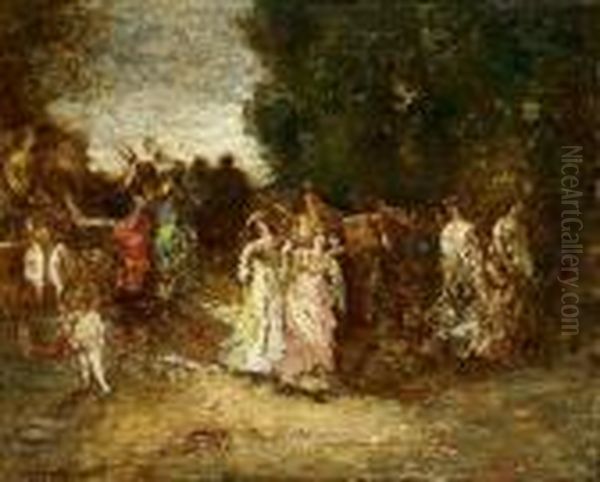
In Paris, Monticelli was profoundly affected by the works of the great Romantic painter Eugène Delacroix. Delacroix's dynamic compositions, expressive brushwork, and, most importantly, his masterful use of vibrant, emotionally charged color, left an indelible mark on the young artist. Monticelli absorbed Delacroix's belief in the primacy of color and its power to convey feeling and atmosphere.
Another significant influence was Antoine Watteau, the 18th-century Rococo master famed for his fêtes galantes – idyllic scenes of aristocratic figures in parkland settings, imbued with a sense of wistful elegance and theatricality. Monticelli was drawn to Watteau's romantic and often melancholic portrayals of leisure and courtship, and this theme would recur throughout his own oeuvre, albeit reinterpreted through his unique stylistic lens. The influence of earlier masters like Titian and Veronese, with their opulent color palettes, can also be discerned in Monticelli's developing aesthetic.
While absorbing these influences, Monticelli was simultaneously forging his own path. He was less interested in the precise draughtsmanship and smooth finish prized by the Academy, and more captivated by the expressive potential of paint itself. He began to experiment with applying paint thickly, using a technique known as impasto, often with a palette knife as well as brushes, creating richly textured surfaces that caught the light in myriad ways. This departure from academic norms set him apart from many of his contemporaries. He also developed a fascination with the Barbizon School painters, such as Narcisse Virgilio Díaz de la Peña, whose romantic landscapes and textured application of paint shared some affinities with Monticelli's burgeoning style.
Artistic Style: A Symphony of Color and Texture
Monticelli's mature style is instantly recognizable. It is a highly personal visual language that defies easy categorization, existing somewhere between the narrative concerns of Romanticism and the purely visual explorations of later movements. His paintings are characterized by an almost sculptural application of paint, with daubs, smears, and thick strokes building up to create a jeweled, mosaic-like surface.
Color was paramount for Monticelli. He employed a rich, often incandescent palette, juxtaposing hues to create a shimmering, vibrant effect. His colors are not merely descriptive but are used to evoke mood, atmosphere, and a sense of otherworldly beauty. Light plays a crucial role, seeming to emanate from within the paintings themselves, catching on the raised surfaces of the impasto and creating a dazzling, almost tactile quality.
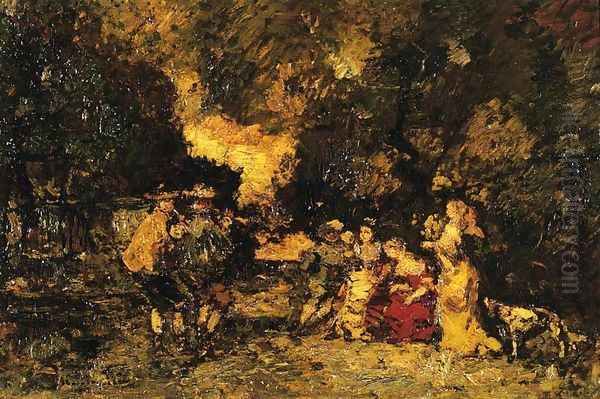
His compositions, while often featuring figures, tend to prioritize overall effect rather than detailed representation. Figures are frequently suggested rather than sharply defined, emerging from or blending into their richly painted surroundings. This creates a dreamlike, almost visionary quality in his work, inviting the viewer to engage imaginatively with the scene. This approach was quite distinct from the clarity sought by Realists like Gustave Courbet or the emerging Impressionists such as Claude Monet and Edgar Degas, who, while also interested in light and color, generally maintained a greater degree of representational fidelity in their early phases.
Key Themes and Subjects
Monticelli's thematic range was diverse, yet consistently filtered through his distinctive stylistic prism. He revisited certain subjects throughout his career, each time imbuing them with his characteristic richness.
Fêtes Galantes and Courtly Scenes: Inspired by Watteau, Monticelli frequently painted scenes of elegant figures in lush, park-like settings. These are not historical recreations but rather romantic evocations of an idealized past, filled with sumptuously dressed ladies and gentlemen engaged in leisurely pursuits, conversation, or music. Works like Fête galante (Courtly Ball) exemplify this genre, where the figures become part of a larger tapestry of color and light.
Still Lifes: Monticelli was a master of the still life, transforming humble arrangements of fruit, flowers, and objects into opulent displays of color and texture. His Still Life with Fruit and Wine Pitcher is a prime example, where the objects almost dissolve into a vibrant interplay of pigments, the paint itself becoming the primary subject. These still lifes are less about meticulous realism and more about celebrating the sensuous beauty of objects and the medium of paint.
Portraits: While perhaps less numerous than his other subjects, Monticelli also undertook portraiture. His portraits often possess a psychological depth, conveyed through his expressive brushwork and rich coloration, capturing not just a likeness but a sense of the sitter's inner world.
Landscapes: His landscapes, such as Sunset, are often imbued with a romantic, atmospheric quality. He was particularly adept at capturing the effects of light at different times of day, using his thick impasto to convey the texture of foliage or the shimmer of water. His collaboration with Cézanne in the Provençal countryside would later yield significant landscape works. Another example, Quatre figures dans un parc (Four Figures in a Park), combines his interest in landscape with figural composition, blurring the lines between genres.
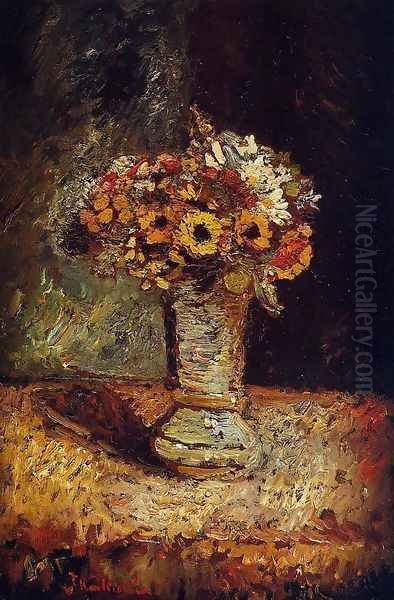
Orientalist Themes: Like Delacroix and many other 19th-century artists, Monticelli was drawn to the perceived exoticism of the East. He painted scenes inspired by North Africa and the Middle East, such as Entrance to the Mosque and Bathroom Scene. These works allowed him to explore rich patterns, vibrant costumes, and dramatic lighting, further indulging his love for opulent color and texture.
The Paris Years, Return to Marseille, and Artistic Development
Monticelli divided his time between Paris and Marseille. In Paris, he absorbed the artistic currents of the day, exhibited his work, and sought patronage. He formed connections with other artists and critics, though his highly individual style often set him apart from prevailing trends. He was not a painter who easily fit into established schools or movements.
The Franco-Prussian War of 1870-1871 marked a turning point. Like many others, Monticelli left Paris during this tumultuous period and returned to his native Marseille. He would spend the remainder of his life in Provence, continuing to paint prolifically. The light and landscape of the South of France undoubtedly resonated with his artistic sensibilities, further enriching his palette and inspiring his work.
It was during his later years in Marseille that his style became even more concentrated and intense. His paint application grew thicker, his colors more daring. While this period saw him produce some of his most distinctive work, it was also a time of increasing financial hardship and relative obscurity within the mainstream art world. His work was not always commercially successful, and he often struggled to make a living.
Interactions with Other Artists: Cézanne and Van Gogh
Despite his somewhat isolated position, Monticelli's art and personality attracted the admiration of several key figures, most notably Paul Cézanne and Vincent van Gogh.
Paul Cézanne: Monticelli developed a significant friendship with Paul Cézanne, a fellow Provençal artist. During the late 1870s and early 1880s, the two artists often painted together in the countryside around Aix-en-Provence and Marseille. Cézanne, who was himself grappling with new ways of representing form and space, was reportedly influenced by Monticelli's freedom of execution and his rich, impastoed surfaces. While their artistic goals ultimately diverged – Cézanne moving towards a more structured, analytical approach – the period of their association was mutually stimulating. Cézanne's respect for Monticelli is well-documented, and he acknowledged the older artist's impact on his own development.
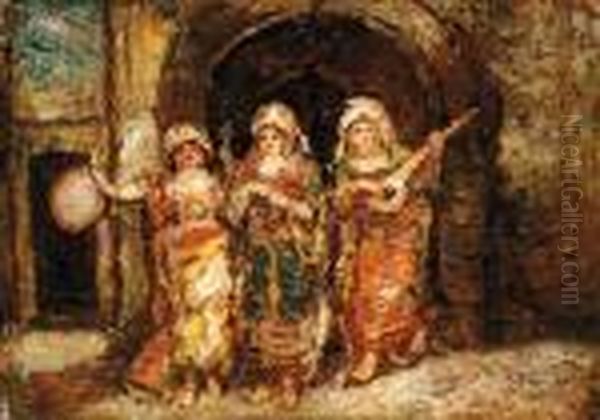
Vincent van Gogh: The impact of Monticelli on Vincent van Gogh was profound and transformative. Van Gogh first encountered Monticelli's paintings in Paris in 1886, after Monticelli's death. He was immediately captivated by the richness of color and the expressive power of the thick paint. Van Gogh wrote enthusiastically about Monticelli in his letters to his brother Theo, calling him "a painter of the South, a man of a pound of wool and a glass of brandy, a dreamer, and a nervous man."
Van Gogh saw in Monticelli a kindred spirit, an artist who prioritized emotional expression and the sensuous qualities of paint. He admired Monticelli's ability to create "a feast for the eyes." Van Gogh's own palette brightened considerably after his encounter with Monticelli's work, and he began to experiment with heavier impasto. He even painted a series of still lifes, Sunflowers, directly inspired by Monticelli's floral pieces, aiming to achieve a similar intensity of color and texture. Theo van Gogh, an art dealer, also recognized Monticelli's talent and helped to promote his work, even publishing a book about him, which further raised Monticelli's posthumous profile. Artists like Camille Pissarro, a leading Impressionist, also had interactions with Monticelli, though perhaps less documented, indicating a degree of mutual awareness within the artistic community.
Challenges, Controversies, and Misunderstandings
Monticelli's career was not without its challenges and controversies. His highly individual style, while admired by some, was often misunderstood or dismissed by conservative critics and the public. The academic establishment, which still held considerable sway, favored a more polished, traditional approach to painting. Monticelli's thick impasto and seemingly "unfinished" surfaces were seen by some as crude or eccentric.
His financial struggles were persistent. Despite his prolific output, he often sold his paintings for very little, sometimes bartering them for basic necessities. The Irish writer Oscar Wilde, a notable aesthete and art collector, was an admirer of Monticelli's work. Wilde reportedly owned several of Monticelli's paintings but was later forced to sell them due to his own financial difficulties, lamenting the decline in Monticelli's market value at one point. This anecdote highlights the fluctuating and often precarious nature of Monticelli's reputation during and shortly after his lifetime.
Furthermore, the very nature of his technique led to issues. His heavy use of pigment and perhaps experimental mediums meant that some of his works faced conservation challenges over time. There were reports of paintings losing their original gloss or vibrancy, which was contrary to the shimmering, jewel-like effect he sought.
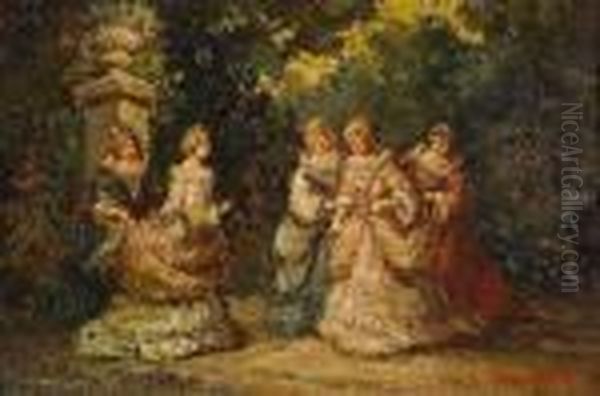
After his death, Monticelli's rising fame, partly fueled by Van Gogh's admiration, unfortunately led to another problem: forgeries. The distinctiveness of his style, paradoxically, made it a target for imitators seeking to capitalize on his posthumous recognition. This complicated the market for his work and sometimes cast doubt on the authenticity of pieces attributed to him.
He also remained somewhat unclassifiable. While some saw him as a late Romantic, others viewed him as a precursor to Impressionism or even Fauvism (a movement that would erupt with artists like Henri Matisse and André Derain nearly two decades after Monticelli's death). Monticelli himself, however, did not align himself with any particular school and seemed content to pursue his own singular vision.
Later Years, Declining Health, and Death
The final years of Adolphe Monticelli's life were marked by continued artistic production but also by increasing poverty and ill health. In 1885, he suffered a stroke that left him partially paralyzed. Despite this debilitating condition, his artistic drive remained. It is said that he continued to conceive of paintings in his mind, even if he could no longer execute them with his previous facility.
Adolphe Monticelli died in Marseille on June 29, 1886, at the age of 61. He passed away in relative obscurity, his genius not yet fully recognized by the wider art world. His death occurred just as Vincent van Gogh was "discovering" his work in Paris, a poignant intersection of artistic legacies.
Legacy and Posthumous Recognition
While Monticelli's fame was limited during his lifetime, his posthumous reputation grew steadily, thanks in large part to the advocacy of artists like Van Gogh and Cézanne, and dealers like Theo van Gogh. His work began to be re-evaluated, and his unique contribution to French painting started to gain wider appreciation.
His influence extended beyond Van Gogh and Cézanne. His bold use of color and expressive impasto can be seen as prefiguring the Fauvist movement, which prioritized intense, non-naturalistic color and painterly freedom. The Scottish Colourists, a group of early 20th-century painters including Samuel Peploe and F.C.B. Cadell, were also known admirers of Monticelli, drawn to his vibrant palette and rich paint application.
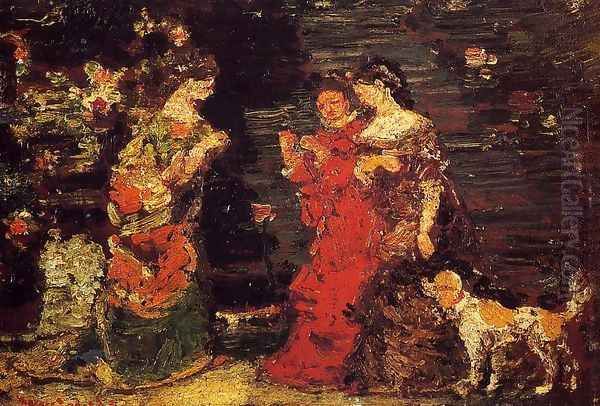
Today, Monticelli's paintings are held in major museums around the world, including the Musée d'Orsay in Paris, the National Gallery in London, and various institutions in the United States. Exhibitions of his work continue to shed light on his unique artistic vision and his place within the broader narrative of 19th and early 20th-century art. He is recognized as an artist who, while perhaps not fitting neatly into art historical categories, possessed an original voice and a profound understanding of the expressive power of paint. His work serves as a vital link between the Romantic tradition and the modernist explorations of color and form that would follow.
Conclusion: An Enduring Radiance
Adolphe Monticelli was an artist driven by an intense personal vision. He pursued his love for opulent color, rich texture, and dreamlike imagery with unwavering dedication, often in defiance of contemporary tastes and financial hardship. His paintings, with their jewel-like surfaces and shimmering light, offer a unique sensory experience, inviting viewers into a world of romantic fantasy and painterly delight.
Though he may have been a maverick, working somewhat outside the mainstream, his impact on subsequent generations of artists, particularly Van Gogh and Cézanne, was significant. He demonstrated that paint itself could be a primary vehicle for emotion and beauty, a lesson that resonated deeply with those who sought to break free from academic constraints. Adolphe Monticelli's legacy is that of a painter's painter, an artist whose passionate engagement with his medium continues to inspire and captivate, his canvases glowing with an enduring, luminous radiance.